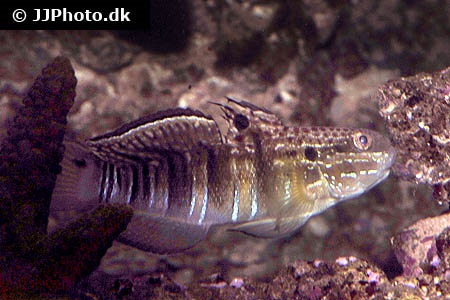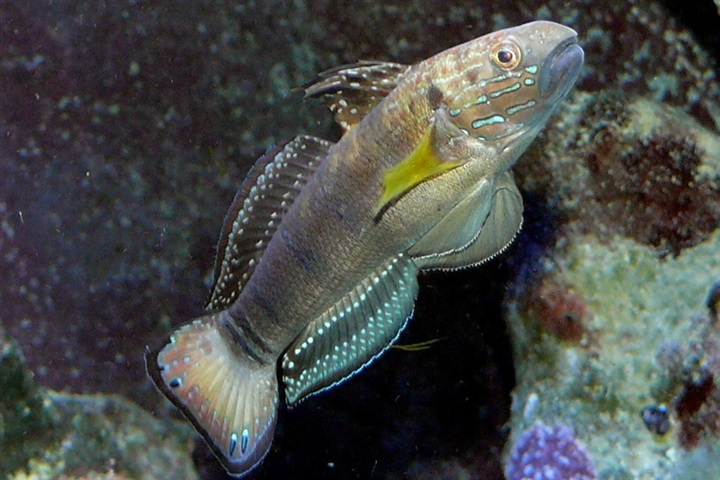Amblygobius phalaena


| Latin name | Amblygobius phalaena - (Valenciennes, 1837) |
|---|---|
| Local name | Sleeper Banded Goby |
| Family | Gobiidae - Amblygobius |
| Origin | East Indian Ocean, Australia, Indonesia, East Pacific, Central/West Pacific |
| Max length | 15 cm (5.9") |
| Minimum volume |
300 l (79 gal) |
|---|---|
| Hardiness |
Hardy |
| Suitable for aquarium |
Suitable with care |
| Reef safe |
Always reef safe |
| Aggressiveness | Mostly peaceful but might be aggressive towards similar species |
| Recommended |
Microalgea (Eg. spirulina) Small crustaceans (Krill, mysis, artemia...) Zooplankton (Cyclops, pods...) |
|---|
This species is known to jump out of open aquaria.
This species has a habit of rearranging rocks and sand.
Make sure rocks are placed securely on the substrate, so they cannot toppled over.
These fish assist in keeping the sandy substrate clean, by filtering sand through the gills for the food it contains.
This can lead to corals being covered with sand.
These fish should be kept in a well run aquarium where they can "graze" algae from rocks and stones.
If there are insufficient algae on the rocks, it is important to feed more frequently and supplement with algae rich food e.g. Spirulina.
These fish prefer a substrate which allows it to burrow.
A substrate consisting of sand, coral pieces, shells and small pieces of broken up shells is ideal for them to dig holes in.
One can also arrange rocks to enable the fish to create a hole underneath, making certain they are secure and cannot fall over.
There should be space to enable them to make a hole which is at least 1½ inch (3 cm) longer than their own body.
Other animals digging in the sand, can stress this species, if the aquarium is not spacious enough. Be therefore aware of, for example of Wrasses which burrow at night.
This species can live as a pair (male and female).
This species comes in multiple color variations which can make identification problematic.
This species is known to feed on flatworms.
One can, of course be unlucky in having a specimen that refuses to eat them.
Amblygobius albimaculatus, Amblygobius phalaena and Amblygobius semicinctus are very similar but they differ in distribution.
Gobies (Gobiidae) are generally small fish, which live close to the bottom. Many of the species are fairly hardy and well suited to aquaria. The behaviour of the different kinds of Gobies varies greatly and some can be very interesting.
The most common types of Gobies in aquaria are the following:
Sand eating Gobies (Amblygobius, Koumansetta and Valenciennea)
Sand eaters filter the sand through their mouths and out of their gills.
They are generally bigger than other Gobies, but they are usually peaceful, so size is not a problem.. They can however be aggressive towards their own species.
One must be aware that they can eradicate the micro life in the substrate when the tank is too small. If there is not enough live food in the sand, it can be difficult to ensure the fish stay in good condition, as they require frequent feeding.
They may spread sand across the corals when they eat.
Shrimp Gobies (Amblyeleotris, Cryptocentrus and Stonogbiops)
Shrimp Gobies have a symbiotic relationship with Pistol shrimps, but one must first find out which species can live together.
The shrimp and Goby live together in a small hole in the sand or under a stone where the shrimp maintains the hole, so it will not collapse over time. The Goby helps by looking out for enemies, since the shrimp does not see well in sunlight, as it will have become accustomed its vision to the darkness of the hole.
Neon Gobies (Elacatinus/Gobiosoma)
Thesef Gobies are very small and like the Cleaner Wrasse, it eats parasites off other fish.
These Gobies are easier to keep alive in the aquarium than Cleaner Wrasses, as they can eat a wide range of foods.
Clown Gobies (Gobiodon)
These fish are very small and therefore suitable for small aquariums. Clown Gobies will often hide inbetween the branches of stony corals, like Acropora for example.
They generally eat many types of food, as long as it is small enough.
| Aquarium trade | Yes |
|---|---|
| Distribution | Pacific Ocean: Philippines to the Society Islands, north to Ryukyu Islands, south to southern Australia (including Lord Howe Island) and Rapa Island; throughout Micronesia. Replaced by Amblygobius albimaculatus in the Red Sea and Amblygobius |
| English common names |
White-spotted goby White-barred goby Banded goby Brown-barred goby |
| Danish common names |
Brunbåndet kutling |
Scott Michael. 2005. Aquarium Fish: Gobies of the Genus Amblygobius - Advanced Aquarist - (English)
Scott W. Michael. Reef Aquarium Fishes: 500+ Essential-to-know Species - TFH Publications / Microcosm Ltd. - (English)
James W. Fatherree. 2011. Aquarium Fish: A Look at the Gobies - Advanced Aquarist - (English)
Bob Fenner. "True" or Combtooth Gobies, the Family Gobiidae - Wet Web Media - (English)

